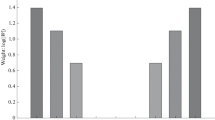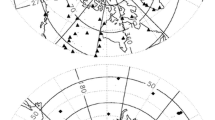Abstract
An attempt is made to verify the hypothesis on the role of geomagnetic disturbances as a factor determining the intensity of traveling ionospheric disturbances (TIDs). To improve the statistical validity of the data, we used the method of global spatial averaging of disturbance spectra of the total electron content (TEC), which is based on the new GLOBDET technology. To characterize the TID intensity quantitatively, we propose using a new global index of the degree of disturbance, which is equal to the mean value of the r.m.s. TEC variations within the chosen range of TID periods (20-60 min in the present case). The analysis was made for a set of 100 to 300 GPS stations, and for 10 days with different levels of geomagnetic activity (the Dst index varied from -13 to -321 nT and the Kp index, from 3 to 9). It was found that as the magnetic disturbance increases, the total intensity of TIDs also increases monotonically; however, the latter correlates not with the absolute value of Dst but with the value of the time derivative of Dst (the maximum correlation coefficient reaches -0.94). The delay about 2 h in the TID response is consistent with the viewpoint that TIDs are generated in auroral regions and propagate toward the equator with a velocity of about 300-400 m/s.
Similar content being viewed by others
REFERENCES
R. D. Hunsucker, Rev. Geophys., 20, No. 2, 293 (1982).
K. Hocke and K. Schlegel, Ann. Geophys., 14, No. 5, 917 (1996).
C. M. Ho, B. A. Iijima, X. P. Lindqwister, A. J. Mannucci, L. Sparks, M. J. Reyes, and B. D. Wilson, J. Geophys. Res. A, 103, No. 11, 26409 (1998).
E. L. Afraimovich, E. A. Kosogorov, L. A. Leonovich, K. S. Palamarchouk, N. P. Perevalova, O. M. Pirog, J. Atmos. Solar-Terr. Phys., 62, No. 7, 553 (2000).
M. Ferster, U. Schwarz, M. H. Fatkullin, N. A. Gasilov, and M. Markwardt, Geomagn. Aéeron., 34, No. 4, 160 (1994).
M. H. Fatkullin, E. V. Zarutskaya, and V. A. Fatkullina, Kosm. Issled., 34, No. 1, 15 (1996).
J. A. Waldock and T. B. Jones, J. Atmos. Terr. Phys., 49, No. 2, 105 (1987).
T. Ogawa, K. Igarashi, K. Aikyo, and H. Maeno, J. Geomagn. Geoelectr., 39, 709 (1987).
F. Bertin, J. Testud, and L. Kersley, Planet. Space Sci., 23, 493 (1975).
W. L. Oliver, Y. Otsuka, M. Sato, T. Takami, and S. Fukao, J. Geophys. Res., 102, 14449 (1997).
V. I. Drobzhev, V. M. Krasnov, and N. M. Salihov, J. Atmos. Terr. Phys., 41, No. 9, 1011 (1979).
Yu. G. Litvinov and A. F. Yakovets, Geomagn. Aéeron., 3, No. 3, 486 (1983).
M. Z. Kaliev, I. M. Krasnikov, Yu. G. Litvinov, B. D. Chakenov, and A. F. Yakovets, Geomagn. Aéeron., 28, No. 2, 316 (1988).
S. V. Fridman, Planet. Space Sci., 38, 961 (1990).
A. F. Yakovets, M. Z. Kaliev, and V. V. Vodyannikov, J. Atmos. Solar-Terr. Phys., 61, No. 8, 629 (1999).
J. A. Klobuchar, Radio Sci., 32, No. 5, 1943 (1997).
E. L. Afraimovich, Radio Sci., 35, No. 6, 1417 (2000).
K. Davies, Space Sci. Rev., 25, 357 (1980).
E. L. Afraimovich, N. P. Minko, and S. V. Fridman, J. Atmos. Terr. Phys., 56, No. 11, 1431 (1994).
J. V. Evans, J. M. Holt, and R. H. Wand, Radio Sci., 18, 435 (1983).
B. Hofmann-Wellenhof, H. Lichtenegger, amd J. Collins, Global Positioning System: Theory and Practice, Springer—Verlag, Wien, New York (1992), p. 327.
E. L. Afraimovich, K. S. Palamartchouk, and N. P. Perevalova, J. Atmos. Sol.-Terr. Phys., 60, No. 12, 1205 (1998).
W. Gurtner, RUNEX: The Receiver Independent Exchange Format Version 2, http://igscb.jpl.nasa.gov/igscb/data/format/rinex2.txt (1993).
J. A. Klobuchar, IEEE Trans. Aerospace Electron. Syst., 23, No. 3, 325 (1986).
T. A. Gailit, V. D. Gusev, L. M. Erukhimov, and P. I. Shpiro, Izv. Vyssh. Uchebn. Zaved., Radiofiz., 26, No. 7, 795 (1983).
R. C. Livingston, C. L. Rino, J. P. McClure, and W. B. Hanson, J. Geophys. Res., 86, 2421 (1981).
M. C. Kelley, K. D. Baker, J. C. Ulwick, C. L. Rino, and M. J. Baron, Radio Sci., 15, No. 3, 491 (1980).
G. L. Gdalevich, V. D. Ozerov, I. S. Vsekhsvyatskaya, L. N. Novikova, and T. N. Sobolev, Geomagn. Aéeron., 20, No. 5, 809 (1980). 773
Author information
Authors and Affiliations
Rights and permissions
About this article
Cite this article
Afraimovich, E.L., Kosogorov, E.A., Lesyuta, O.S. et al. Geomagnetic Control of the Spectrum of Traveling Ionospheric Disturbances Based on Data from a Global GPS Network. Radiophysics and Quantum Electronics 44, 763–773 (2001). https://doi.org/10.1023/A:1013760814426
Issue Date:
DOI: https://doi.org/10.1023/A:1013760814426




